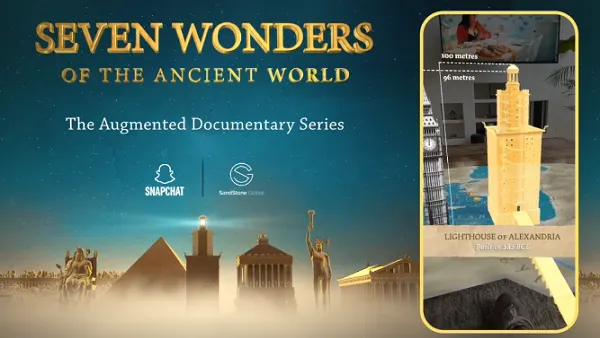Introduction: A New Era for Interactive Television
Television has always been a window to the world. For decades, audiences have relied on the medium to inform, entertain, and inspire. But in an age where digital platforms and emerging technologies redefine how content is consumed, television alone is no longer enough to keep audiences fully engaged.
Snapchat, a platform best known for its playful filters and instant messaging features, is stepping into this evolving space with a bold innovation — Snapchat AR TV integration. This new initiative transforms a traditional documentary into a multi-sensory, interactive experience, bringing viewers closer than ever to history’s most iconic architectural marvels: the Seven Wonders of the Ancient World.
The Partnership: History Meets Innovation
In collaboration with a leading U.K. television broadcaster, Snapchat has embedded augmented reality (AR) elements directly into the broadcast of a new documentary series. The program, hosted by acclaimed historian Bettany Hughes OBE, revisits the mysteries, achievements, and cultural significance of ancient landmarks built over two millennia ago.
This partnership represents a meeting of two worlds: the meticulous storytelling of a historian and the immersive, real-time capabilities of AR technology. It offers a rare opportunity for viewers to not just watch history, but to explore it with the kind of interactivity that was once the realm of museums and virtual reality installations.
How the Snapchat AR TV Integration Works
At key moments in the program, viewers see a QR code appear on-screen. With a quick scan using their smartphone, they unlock a corresponding AR activation in the Snapchat app. These activations open three-dimensional recreations of the wonders being discussed, which can be viewed from multiple angles and scaled to fit the user’s space.
Imagine watching the segment on the Great Pyramid of Giza and, within seconds, having a precise, scaled-down model projected onto your living room table. Or, during the exploration of the Hanging Gardens of Babylon, seeing lush, terraced greenery unfold before your eyes in augmented reality.
The technology turns passive viewing into active exploration, bridging the gap between traditional media and interactive digital experiences.
The Seven Wonders in Focus
The documentary covers all seven wonders:
- The Great Pyramid of Giza – The only surviving ancient wonder, standing as a testament to engineering ingenuity and human ambition.
- The Hanging Gardens of Babylon – A marvel of horticulture and architectural artistry, recreated in AR to show its rumored splendor.
- The Statue of Zeus at Olympia – A massive gold-and-ivory masterpiece that once honored the king of the Greek gods.
- The Temple of Artemis at Ephesus – Known for its grandeur and scale, reconstructed virtually to reveal its lost details.
- The Mausoleum at Halicarnassus – An elaborate tomb blending Greek, Egyptian, and Lycian design influences.
- The Colossus of Rhodes – A towering bronze figure that symbolized triumph and resilience.
- The Lighthouse of Alexandria – An engineering marvel that guided ancient mariners, digitally resurrected for modern viewers.
Through the Snapchat AR TV integration, each wonder is not only described but visually brought to life in ways that deepen understanding and appreciation.
Educational Storytelling Reinvented
Traditional documentaries rely on archival footage, expert commentary, and occasionally, computer-generated imagery (CGI) to illustrate the past. This project adds another layer: audience participation.
By merging Bettany Hughes’ expert storytelling with AR interactivity, viewers receive both historical knowledge and a personal encounter with the monuments. This dual approach appeals to a wide demographic—history enthusiasts, students, families, and even casual viewers who might not otherwise engage deeply with educational content.
Reaching Beyond Snapchat’s Core Audience
Snapchat’s user base has historically skewed younger, with a strong focus on quick, shareable content. This initiative signals a strategic shift towards broader audience engagement. By aligning with a reputable educational program, Snapchat positions itself as a platform for intellectual enrichment as well as entertainment.
Older viewers, who may not typically use Snapchat, have a compelling reason to download the app and try its AR capabilities. This could expand the platform’s demographic reach and strengthen its brand perception.
The Broader Implications for AR in Media
The Snapchat AR TV integration is more than a one-off experiment—it’s a potential blueprint for the future of television. As AR glasses and wearable tech move closer to mainstream adoption, similar integrations could become standard for historical documentaries, travel shows, cooking programs, and even live sports.
Imagine sports broadcasts with 3D stats floating in your living room, or cooking shows where you can view an interactive recipe hologram alongside the chef. The possibilities are vast, and Snapchat’s experiment with the Seven Wonders offers a glimpse of what’s possible.
Benefits for Viewers
- Immersive Engagement: Viewers can interact with content in real-time, making learning more memorable.
- Personalized Experience: AR activations can be explored at the viewer’s own pace and from unique perspectives.
- Enhanced Retention: Interactive experiences have been shown to improve information retention compared to passive watching.
Challenges and Considerations
While the integration is groundbreaking, it comes with challenges:
- Accessibility: Viewers need both a smartphone and the Snapchat app installed to participate.
- Adoption Curve: Some audiences may be unfamiliar with QR code scanning and AR functionality.
- Production Costs: Creating high-quality AR content requires significant investment in design and development.
Nonetheless, these challenges are outweighed by the benefits, particularly as AR familiarity grows globally.
A Step Toward the Future of Learning and Entertainment
This collaboration demonstrates how modern technology can rejuvenate interest in historical subjects and inspire curiosity about the world’s cultural heritage. It also highlights Snapchat’s commitment to pushing the boundaries of AR beyond fun filters and entertainment, venturing into serious educational territory.
As the media landscape continues to evolve, the Snapchat AR TV integration serves as a model for how platforms and broadcasters can work together to create richer, more engaging, and more impactful viewer experiences.
Conclusion
By blending expert historical storytelling with cutting-edge AR capabilities, Snapchat has turned a conventional documentary into a dynamic, participatory journey through time. The project invites viewers not just to watch history, but to inhabit it—exploring legendary sites as if they were standing there in person.
In doing so, Snapchat is redefining the boundaries between media formats, proving that the future of television is not about replacing the screen but about enhancing it with interactive, immersive layers that bring stories to life.




